 | Questions & Answers |
What is the Cabinet of Curiosities?The Cabinet of Curiosities represents the development of science in Australia over the past two centuries, since Joseph Banks's voyage aboard the original Endeavour. It is a complex piece with many elements and many layers of meaning, but can be understood as:
Who made the Cabinet?The Cabinet is result of collaboration between historians, artists and craftspeople. The project was developed and managed by Tim Sherratt of the Australian Science Archives Project (University of Melbourne). Tim is a historian who has worked for a number of years to promote access to, and interest in, the history of Australian science.The Cabinet itself was designed and built by Greg St John from the Canberra School of Art. Greg is passionate about working with timber, and found that making the Cabinet challenged and extended his skills. The artists who contributed to the project came from around Australia, with a wide variety of interests and experiences. What is the link with the Endeavour?Joseph Banks's work aboard the original Endeavour introduced Australia to the practices and processes of western science. Two hundred years later, Australia has developed its own active and innovative scientific culture. The Cabinet tells the story of this development. By arriving in Britain aboard the replica Endeavour, the Cabinet in some ways completes Banks's journey - the enterprise he initiated has been fulfilled.What is going to happen to the Cabinet?The Cabinet of Curiosities is being presented as a gift from the people of Australia to the Royal Society of London. No doubt it will be exhibited at various times in the future. All of the people working on the project were well aware that they were making an 'antique of the future' - the Cabinet will remain an object of interest and debate for at least another two centuries! What will people in the future make of it? How will they understand its intellectual and artistic framework? The Cabinet of Curiosities both presents and makes history.Where can people see the Cabinet of Curiosities?The Cabinet will be included as part of the Kaleidoscope of Life exhibition, being developed by the Natural History Museum and the Australian Museum. This exhibition will tour Australia, before returning to Britain in 1999.What is the design of the Cabinet?The project had many sources of inspiration, including Banks's wooden chests aboard the Endeavour, and the collectors' cabinets assembled by gentlefolk of the eighteenth and early nineteenth centuries. However, the Cabinet of Curiosities is not a replica of any particular piece. It is a totally orginal design that incorporates a number of historical references:
The Cabinet is constructed in three sections that can be separated for display purposes, these three sections correspond to the three main themes running though the project. The first section comprises a series of four shallow trays. The second sections contains six half width drawers (in pairs). The final section consists of two full-width drawers. The three sections are held together by heavy iron side bars and a wooden cross beam. How were the contents developed?The design of the Cabinet provides 9 display spaces (drawers or trays) grouped in three sections. A story was developed for each of these spaces that brought together various characters, events and achievements from the history of Australian science. These stories were intended not just as a summary of Australia's scientific development, but as an introduction to some of the main questions and problems that bear on our understanding of the scientific past. Eight artists were chosen to contribute to the project, and each was presented with a space and a story - it was then up to them to respond to the story in whatever way they wished to fill their space.What are the themes?The three themes that correspond to the three sections of the Cabinet of Curiosities are:
|
[ The Cabinet | Bright Sparcs | ASAPWeb ]
Prepared by Tim Sherratt (Tim.Sherratt@asap.unimelb.edu.au)
for publication on ASAPWeb. Last modified 22 June 1997.